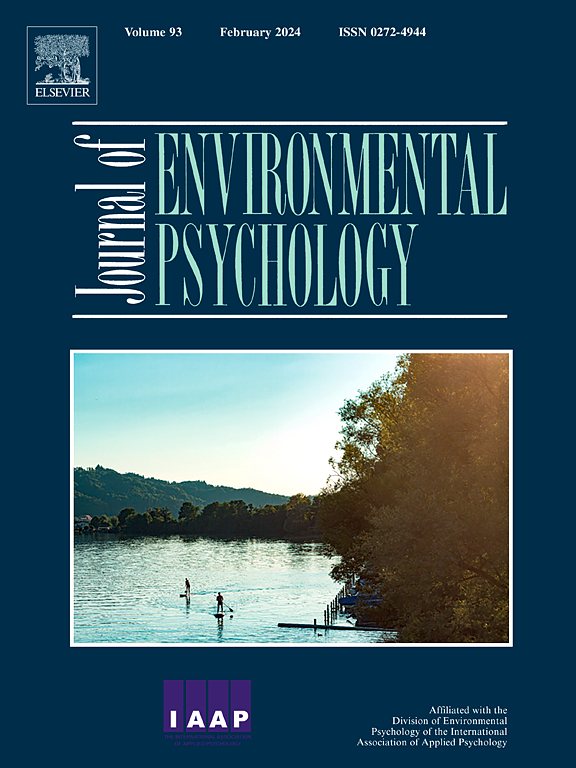Assessment of the Hogg eco-anxiety scale (HEAS): psychometric validation and associated characteristics in Brazilian adolescents
IF 7
1区 心理学
Q1 ENVIRONMENTAL STUDIES
引用次数: 0
Abstract
Eco-anxiety is an increasingly common emotional response to climate and ecological crises. Our aim was to evaluate the psychometric properties of the Hogg Eco-Anxiety Scale (HEAS) Portuguese version; examine sex invariance; and investigate socioeconomic and health-related and psychological characteristics associated with eco-anxiety among Brazilian adolescents belonging to the 2004 Pelotas Birth Cohort, at 18 years of age. The psychometric properties of the HEAS were evaluated through confirmatory factor analysis. Differences in mean eco-anxiety scores across categories of maternal and adolescent characteristics were examined using one-way ANOVA. Associations with continuous independent variables were explored using correlation analyses. Adjusted analyses were conducted using a hierarchical model in a multivariate linear regression. The total HEAS score showed good internal consistency (Cronbach's α = .875), with all dimensions also reliable (affective symptoms: α = .81; rumination: α = .79; behavioral symptoms: α = .71; and anxiety about personal impact: α = .77). Factor loadings and item means were consistent across sexes. In adjusted models, considering total HEAS score, higher eco-anxiety levels were found among females, adolescents whose mothers had lower education levels or were non-white, and those whose mothers experienced depression symptoms. Lower eco-anxiety levels were observed among adolescents with higher self-esteem and emotional regulation, while higher levels were found among those with a more external locus of control and greater perceived stress. Our results support the four-factor model of the scale and indicate that the HEAS is valid for assessing eco-anxiety in adolescents from southern Brazil. The validated scale can facilitate future research and interventions aimed at mitigating eco-anxiety in Brazil.
霍格生态焦虑量表(HEAS)的评估:巴西青少年的心理测量验证和相关特征
生态焦虑是对气候和生态危机的一种日益普遍的情绪反应。我们的目的是评估霍格生态焦虑量表(HEAS)葡萄牙语版的心理测量特性;检查性别不变性;并调查2004年佩洛塔斯出生队列中18岁的巴西青少年与生态焦虑相关的社会经济、健康相关和心理特征。通过验证性因子分析对HEAS的心理测量特性进行评价。使用单因素方差分析检查了不同类别的母亲和青少年特征的平均生态焦虑得分的差异。使用相关分析探讨与连续自变量的关联。采用多元线性回归的层次模型进行调整分析。HEAS总分具有良好的内部一致性(Cronbach's α = .875),各维度均可靠(情感症状:α = .81;反刍:α = .79;行为症状:α = .71;对个人影响的焦虑:α = .77)。因子负荷和项目均值在两性之间是一致的。在调整后的模型中,考虑到HEAS总分,女性、母亲受教育程度较低或非白人的青少年以及母亲有抑郁症状的青少年的生态焦虑水平较高。自尊和情绪调节能力强的青少年生态焦虑水平较低,而外部控制点多、感知压力大的青少年生态焦虑水平较高。我们的研究结果支持该量表的四因素模型,并表明HEAS在评估巴西南部青少年生态焦虑方面是有效的。经过验证的量表可以促进未来的研究和干预措施,旨在减轻巴西的生态焦虑。
本文章由计算机程序翻译,如有差异,请以英文原文为准。
求助全文
约1分钟内获得全文
求助全文
来源期刊

Journal of Environmental Psychology
Multiple-
CiteScore
10.60
自引率
8.70%
发文量
140
审稿时长
62 days
期刊介绍:
The Journal of Environmental Psychology is the premier journal in the field, serving individuals in a wide range of disciplines who have an interest in the scientific study of the transactions and interrelationships between people and their surroundings (including built, social, natural and virtual environments, the use and abuse of nature and natural resources, and sustainability-related behavior). The journal publishes internationally contributed empirical studies and reviews of research on these topics that advance new insights. As an important forum for the field, the journal publishes some of the most influential papers in the discipline that reflect the scientific development of environmental psychology. Contributions on theoretical, methodological, and practical aspects of all human-environment interactions are welcome, along with innovative or interdisciplinary approaches that have a psychological emphasis. Research areas include: •Psychological and behavioral aspects of people and nature •Cognitive mapping, spatial cognition and wayfinding •Ecological consequences of human actions •Theories of place, place attachment, and place identity •Environmental risks and hazards: perception, behavior, and management •Perception and evaluation of buildings and natural landscapes •Effects of physical and natural settings on human cognition and health •Theories of proenvironmental behavior, norms, attitudes, and personality •Psychology of sustainability and climate change •Psychological aspects of resource management and crises •Social use of space: crowding, privacy, territoriality, personal space •Design of, and experiences related to, the physical aspects of workplaces, schools, residences, public buildings and public space
 求助内容:
求助内容: 应助结果提醒方式:
应助结果提醒方式:


